Paint. Heal. Grow.
September 2017
Summary
Exposure to visual art and participation in creative activities creates positive brain changes. In this report, Art & Creativity for Healing highlights some of our favorite data and quotes surrounding this hypothesis.
We’ve collected information from a variety of sources, and the results are overwhelming: exposure to visual art and participation in creative activities creates positive brain changes.
In this report, Art & Creativity for Healing highlights some of our favorite data and quotes surrounding this hypothesis. Read on to see how you can use art to change the brain, create wellness, and improve quality of life.
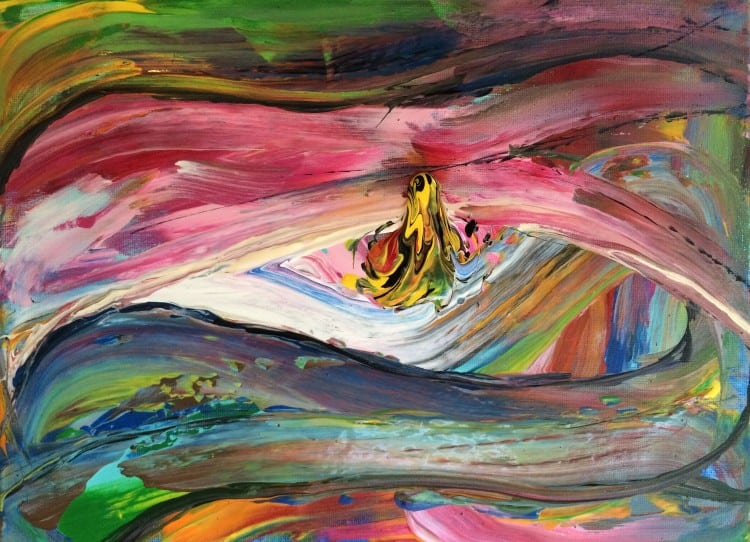
Art to the Forefront
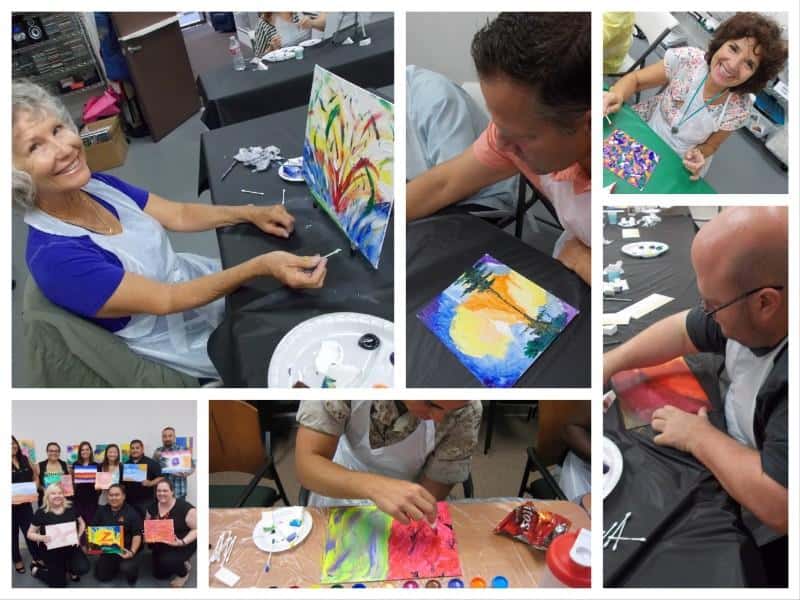
Artistic and creative outlets contribute positively to peoples’ well-being. It’s been historically difficult to put unbiased “hard statistics” to this hypothesis.
Researchers are placing more emphasis on the benefits of creativity and quantifying it in increasing detail. Advances in medical technology have allowed scientists to study the precise physical effects of stimuli on the brain. Addiction and pain management treatment has undergone philosophical shifts in the past decades. These shifts have spurned increased study into the effect of visual art on the brain and its use as a therapeutic tool.
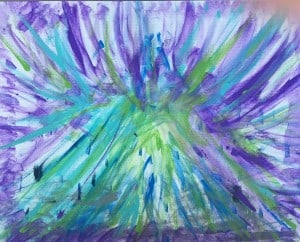
Art Changes the Brain
It’s been shown that creative expression is a powerful tool for well-being. However, little has been known about the underlying neurological cause until recent years. The brain’s structure is being revealed through advanced fMRI studies. Neuroplasticity is key in the brain’s evolution, structure, and ability to repair, or re-channel pathways.
Because exposure to art invokes and stimulates both brain hemispheres, creating or viewing art stimulates the motor cortex even though there may be no movement involved. This is an exciting advance in treating neurological conditions such as stroke and traumatic brain injury. (Demarin, Bedeković, Puretić, & Pašić, 2016)
In one study
This proves even more that art has positive healing effects on the brain.
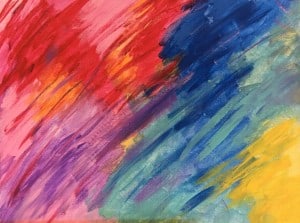
Art Improves Critical Thinking and Empathy
Seeing the changes that art invokes in students, medical schools are requiring physicians in training to take creative courses to mold their critical thinking skills. Penn State began their medical humanities program in 1967 and other universities continue to follow suit.
Why have a physician take an Impressionist art course? Professors find that performing arts, music, literature, and the visual arts build critical thinking, observation, communication, bias awareness, and empathy skills that “science” just can’t provide.
At Yale, Harvard, and University of Texas Austin, medical students are required to visit museums and describe the works in precise detail. (Lesser, 2017) At first this may look unrelated to medicine. However, the course is teaching students important observational skills to aid in future diagnoses. Like the medical school approach, Art4Healing Workshops create a group experience allowing the participants to observe, reflect, and share emotional responses about their inner dialogue in a safe and confidential environment.

Art Means Less Depression, Pain, Medical Intervention
Deep activation of brain systems through art reduces stress and creates happiness. This means less doctor visits, at least in a case study with the Artlift arts-on-prescription project in Gloucestershire, England. Artlift serves patients with a wide range of conditions, from depression to chronic pain to stroke.
These patients were referred to an eight-week course involving poetry, ceramics, drawing, mosaic or painting. A cost-benefit analysis showed a 37% reduction in GP consultation rates and a 27% reduction in hospital admissions. That represents an NHS (National Health Service) saving of £216 ($280) per patient. Imagine that cost savings if extrapolated to the population! (All-Party Parliamentary Group on Arts, 2017)

A Doctor's Perspective

Art & Creativity for Healing’s services provide many of the benefits outlined in the studies above. We wanted an expert opinion from someone with first-hand knowledge of our organization.
Dr. Carolyn Cherie has experienced the Art4Healing methodology as a participant and as an observer of the method. She participated at several locations where foster youth and at-risk teens have joined an Art4Healing workshop.
Dr. Cherie said: “As a Psychologist, I believe in this method as I have seen firsthand its transformative power during workshops with foster youth. The teens quickly relaxed and were able to document feelings using painted colors to express different intensities of emotions such as fear and anger.”
Dr. Cherie’s quote, along with the other opinions and studies in this report, solidifies our mission’s value: to support emotional healing through art & creative expression for those living in pain, grief, fear or stress.
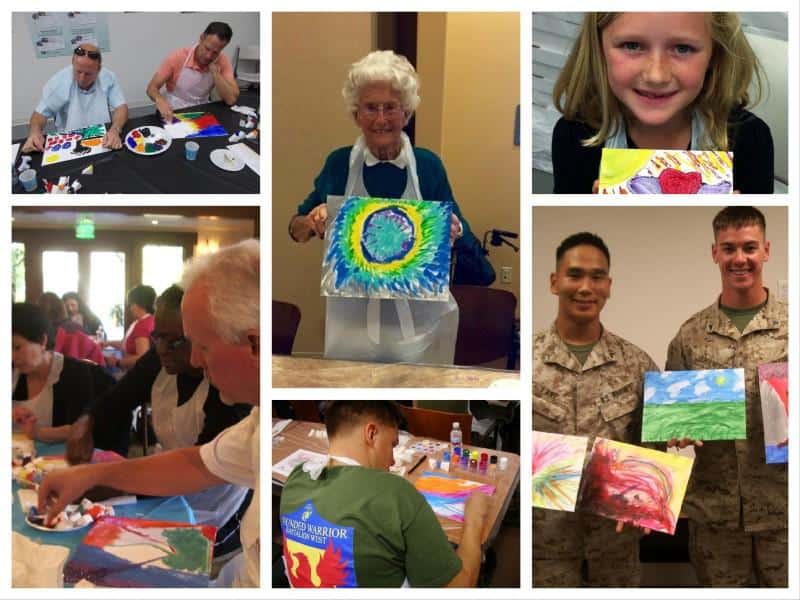
Cope with stress
I find great relief after we have completed each class. It has helped me deal with stress and chronic anxiety.
This class has helped me express my healing process more than traditional therapy itself. Please keep this class going to help others as well.
Wounded Warrior Participants
Choose art
I love getting the chance to stop the cogs of my brain and step out of my head and express. When I’m done I get to step back and look at a portrayal of my heart and mind without judgment and make new connections. I LOVE IT. It is so helpful and IMPORTANT.
Wounded Warrior Participant
Build Team Empathy
Hearing other co-workers’ thoughts and insights helped me see where everyone was on our team.
Gregg Eisenman, Hotel Management
Build Team Empathy
Art & Creativity for Healing has facilitated our staff retreats for the past 5 years with exceptionally high ratings from our employees.
St. Joseph Healthcare System
Choose art
It surprised me how interactive and innovative this Art4Healing process was—anyone can do it without needing to be an artist. I learned some new things about my staff due to this process. I was so impressed with the first workshop that I sent our Operations Team over as well. They too had a powerful, engaging team-building experience.
Paul Giobbi, Founder/CEO of Zumasys
Invest in Creativity!
These exciting advancements in evaluating visual art and the brain are the tip of the iceberg. It is convincing that regular creative visual art exercises are worth the effort. It’s easy for anyone to get started. Collage, journaling, and painting all provide benefits and require minimal investment. So, what are you waiting for?
References
- All-Party Parliamentary Group on Arts, H. a. (2017). Creative Health: The Arts for Health and Wellbeing. London, UK. Retrieved from http://www.artshealthandwellbeing.org.uk/appginquiry/Publications/Creative_Health_Inquiry_Report_2017.pdf
- Bolwerk, A., Mack-Andrick, J., Lang, F. R., Dörfler, A., & Maihöfner, C. (2014). How Art Changes Your Brain: Differential Effects of Visual Art Production and Cognitive Art Evaluation on Functional Brain Connectivity. PLOS One. Retrieved from http://journals.plos.org/plosone/article?id=10.1371/journal.pone.0101035
- Campbell, D. (2014, July). This is your brain on art: a Q & A with Oshin Vartanian. University of Toronto News. Retrieved from https://www.utoronto.ca/news/your-brain-art-q-oshin-vartanian
- Demarin, V., Bedeković, M. R., Puretić, M. B., & Pašić, M. B. (2016). Arts, Brain, and Cognition. Psychiatria Danubina, 2016; Vol. 28, No. 4, pp 343–348. Retrieved from
http://www.hdbp.org/psychiatria_danubina/pdf/dnb_vol28_no4/dnb_vol28_no4_343.pdf - Lesser, C. (2017, August). Why Med Schools Are Requiring Art Classes. Artsy Editorials. Retrieved from https://www.artsy.net/article/artsy-editorial-med-schools-requiring-art-classes